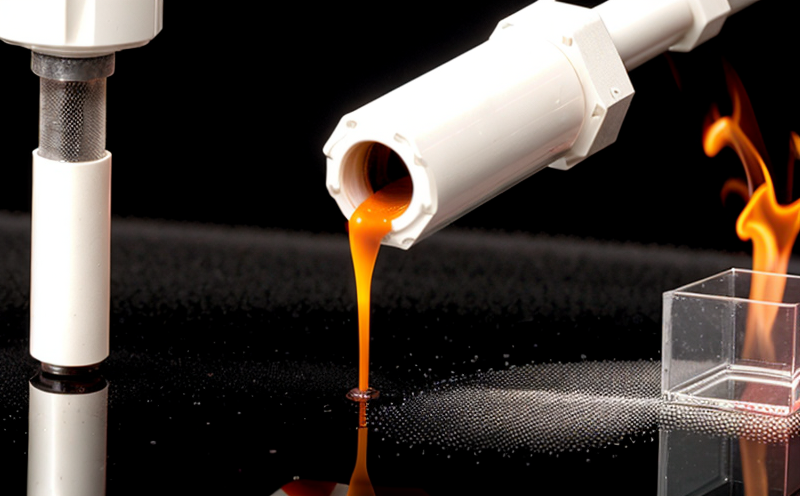ISO 23154 Oxidation Resistance of Nanostructured Materials at High Temperatures
The ISO 23154 standard is a critical tool in the assessment of oxidation resistance properties of nanostructured materials when subjected to high-temperature environments. This test method is particularly valuable for industries such as aerospace, automotive, and electronic components manufacturing, where materials are exposed to extreme conditions. The primary objective of this test is to evaluate the stability and durability of nanomaterials over time under elevated temperatures.
Understanding oxidation resistance in nanostructured materials is crucial because these materials often exhibit unique physical and chemical properties due to their small size and large surface area-to-volume ratio. These properties can significantly influence how they behave when exposed to environmental factors like oxygen, moisture, or other reactive species at high temperatures. The ISO 23154 test provides a standardized approach to quantify the extent of oxidation that occurs over specified periods under controlled conditions.
The test involves exposing nanostructured samples to an oxidizing environment at defined temperatures for predetermined durations. Samples are typically subjected to oxygen-rich atmospheres, such as air or pure oxygen, and temperature ranges can vary widely depending on the application. Common testing parameters include 100°C up to 800°C or higher, although specific limits may depend on the material being tested.
Sample preparation for this test is meticulous. Specimens must be cut into uniform shapes and sizes that allow consistent exposure to the oxidizing environment without affecting the outcome of the test. The surface area-to-volume ratio plays a critical role in determining how quickly oxidation will proceed, so care is taken during sample fabrication to maintain these ratios.
The testing apparatus used for ISO 23154 typically includes furnaces capable of maintaining precise temperature control and humidity levels if required by the specific conditions. In some cases, controlled atmosphere ovens are utilized to ensure that only specified gases are present in the chamber. The furnace must be able to heat specimens uniformly across the sample area while allowing for easy observation or measurement.
After exposure, samples undergo detailed analysis using techniques such as scanning electron microscopy (SEM) and X-ray diffraction (XRD). These methods help identify changes in crystal structure and composition resulting from oxidation. Weight loss measurements are also conducted to quantify the amount of mass lost due to chemical reactions with oxygen during testing.
The acceptance criteria for this test vary based on the intended use of the nanomaterials but generally focus on maintaining structural integrity, minimizing weight loss, and preserving functional properties after exposure. Compliance with these standards ensures that materials used in high-temperature applications remain reliable throughout their lifecycle.
Scope and Methodology
The scope of ISO 23154 covers the evaluation of oxidation resistance for nanostructured materials under controlled temperature conditions. This includes assessing the extent to which these materials can resist degradation due to oxidative processes when exposed to high temperatures.
- Temperature Range: Typically between 100°C and 800°C, but this may extend higher depending on specific material requirements.
- Oxidizing Environment: Usually air or pure oxygen, though other gases can be used as specified by the application.
- Duration of Exposure: Varies based on intended use and desired outcome, often ranging from hours to days.
The methodology involves preparing representative samples of nanostructured materials according to standard procedures. These samples are then placed into a controlled environment where they are exposed to the specified temperature and oxidizing atmosphere for the required duration. Post-exposure analysis includes visual inspection, microstructural examination using SEM or TEM (Transmission Electron Microscopy), and quantitative measurements like weight changes.
Standard compliance ensures that all tests follow internationally recognized guidelines ensuring accurate and reproducible results. This standardization is essential in industries where precision and consistency are paramount for quality assurance purposes.
Why Choose This Test
The ISO 23154 test offers several advantages over other methods when it comes to evaluating the oxidation resistance of nanostructured materials at high temperatures. One key advantage is its ability to provide precise data about how these materials perform under realistic operating conditions, which can help in predicting their long-term performance more accurately.
Another significant benefit is that this test allows manufacturers and researchers to compare different types of nanomaterials easily by applying consistent testing protocols. This comparability across various products ensures fair competition among suppliers while also aiding in selecting the most suitable material for particular applications.
Moreover, compliance with ISO 23154 helps companies meet regulatory requirements related to product safety and environmental impact assessments. By ensuring that their materials pass this stringent test, businesses demonstrate commitment to maintaining high standards of quality control throughout production processes.
A third reason is the ability of this test to identify potential weaknesses early in development stages, allowing for improvements before full-scale manufacturing begins. Early detection of issues related to oxidation resistance can save significant costs associated with rework or recalls later down the line.
Lastly, adherence to international standards like ISO 23154 enhances trust between suppliers and customers by providing a common language understood globally. It fosters collaboration among stakeholders involved in nanotechnology research and development activities worldwide.
Use Cases and Application Examples
- Aerospace Industry: Ensuring that lightweight yet durable components like turbine blades or engine parts remain functional despite prolonged exposure to high temperatures during flight operations.
- Automotive Sector: Verifying the reliability of exhaust systems, catalytic converters, and other critical components exposed to harsh environments during vehicle usage.
- Electronic Devices: Confirming that circuit boards and semiconductors retain their integrity when subjected to elevated temperatures during manufacturing or end-user operation.
- Military Applications: Assessing the performance of electronics and structures used in defense equipment where reliability under extreme conditions is vital.
In each case, understanding how nanostructured materials behave at high temperatures is crucial for designing products that meet stringent performance expectations. The ISO 23154 test provides a reliable means of gathering this information.





